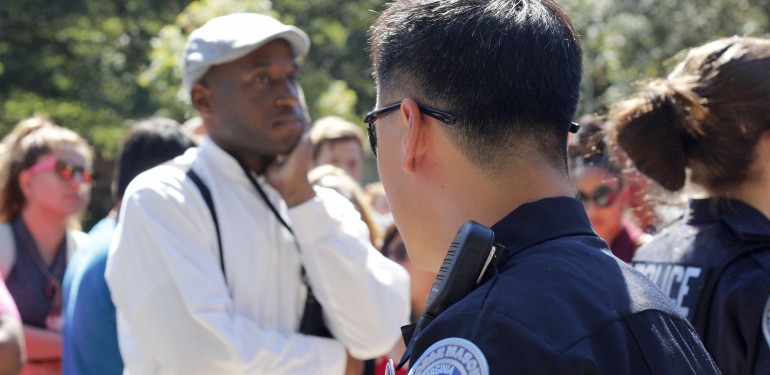This story was originally published in the February 2 issue of Fourth Estate.
The City of Fairfax Police Department are now considering the use of body-worn cameras following the controversy surrounding the highly publicized deaths of Michael Brown and Eric Garner.
According to local news source The Connection, Carl Pardiny, the Chief of Police for Fairfax City, stated that advancing technology allowed the police department to implement the use of body-worn cameras. The cameras will complement the cameras currently mounted in patrol vehicles.
The City of Fairfax Police Department is not alone in its decision regarding the use of the cameras. NPR stated in a recent article that these cameras are quickly becoming a part of standard-issue gear for American police. The intent of the camera is to eliminate any room for racial bias and excessive force by police departments.
The demonstrations in Ferguson, Missouri following the decision of the grand jury to not indict officer Darren Wilson in the death Michael Brown commanded the media’s attention on a national level, with protests held nationwide.
The Washington Post reported on the protests that took place in downtown Washington, saying that protesters were marching for the injustices of the Michael Brown case.
Mason’s public forum, “Policing the Black Body,” gave students the opportunity to discuss the events that occurred in Ferguson as well as potential solutions for preventing future instances.
Dr. Wendi Scott, director of African American studies, was a panelist at the event. She agrees with the decision to implement the use of body-worn cameras.
“I think that body cameras are an essential and good first step; however, they are not (and cannot) be the only solution,” Scott said.
Some have argued that the use of body cameras is a step backward for the nation, while others have also questioned the success of cameras in providing justice.
Eric Garner, an unarmed black man, died last July after a New York City police officer placed him in a chokehold during an arrest. A bystander recorded the scene as it unfolded.
The bystander’s video footage is an example of a scenario that a police-worn body camera would record. The Washington Post stated that the grand jury’s decision to not indict the officer in the Eric Garner case, even with the presence of the bystander’s video footage, points to the potential ineffectiveness of police using body-worn cameras as a means of evidence.
“The story of Eric Garner suggests that cameras alone will not create a more safe and just system. Most would agree that retraining and changes in policing are required,” Scott said.
However, like Fairfax City, many police departments across the nation are beginning to implement the use of body-worn cameras. With the influx of police departments mandating the use of these cameras, it is not clear if this protocol will apply to the police forces at the university level.
Thomas Longo, The Assistant Chief of Police for Mason’s Police Department said that many agencies are interested in the idea of body-worn cameras, but Mason may not be among them.
“The cameras are regarded as a protective measure for both the public and the officer. While I cannot speculate as to the precise calculus employed by the City of Fairfax, I can say that the Mason Police Department is also exploring this technology,” Longo said.
As for the future requirement of body-worn cameras for Mason police officers, Longo said, “No timeline for acquisition or final decision has been determined. We are examining alternatives.”
Senior Cameron Wallace said, “Mason Police should abide by the same procedures as the Fairfax City Police Department by implementing the use of body-worn cameras.”
On the necessity of the cameras, Wallace said, “Body-worn cameras ensure the integrity of the police officer while giving less room for fabrication in the courtroom of all parties involved.”
The video evidence that these cameras obtain does not come at a small cost. The body-worn cameras impose a considerable cost to police departments. The Atlantic reported that the cameras cost anywhere from $800-$1,000 each.
“I do not feel that the expense of the body-worn cameras would be cost-effective for a smaller scale police force such as Mason Police,” said freshman Natalie Schulhof.
The necessity of small-scale police departments like Mason Police implementing the use of body-worn cameras is yet to be determined.
“Quite honestly, I think that if Mason Police implemented the use of body-worn cameras it would become more of a problem and less of a solution. I do not feel the implementation of body-worn cameras is necessary in Fairfax,” Schulhof said.
Junior LaDesha Batten, a member of Mason’s Black Student Alliance, supports the decision made by the City of Fairfax Police Department. She feels the decision was not based solely on the events in Ferguson, but that the events may have expedited the decision.
“I wouldn’t say the decision was only made because of the death of Michael Brown and the events which followed in Ferguson; but I would say the events had an impact on the department’s decision,” Batten said.
As for the potential of Mason Police implementing the use of body-worn cameras, Batten said, “It could be useful, however, Mason isn’t really a school where a lot of on-campus incidents happen, so I don’t feel it would be necessary.”
Photo credit: Amy Rose
Revision #1: The original version of this story stated that the Fairfax Police Department has decided to use body-worn cameras. The decision for the cameras is still under consideration. This version reflects this change.
Revision #2: The original version of this story attributed the chief of the City of Fairfax police as “Carl Perdiny,” the correct spelling of his name is Carl Pardiny. This version has been corrected.




